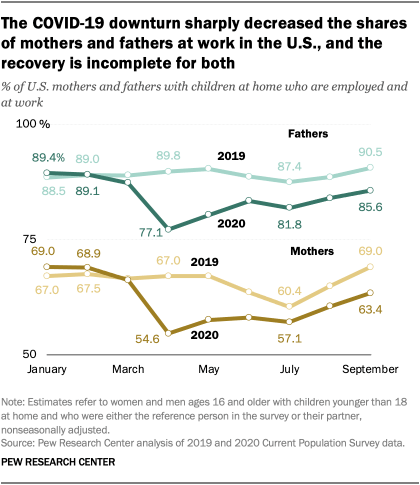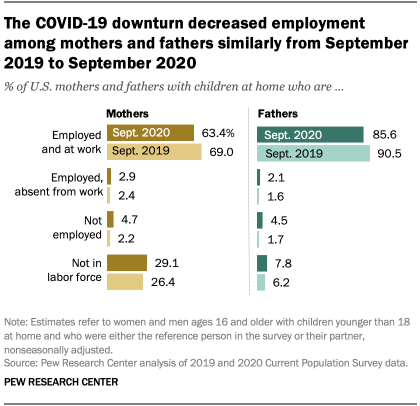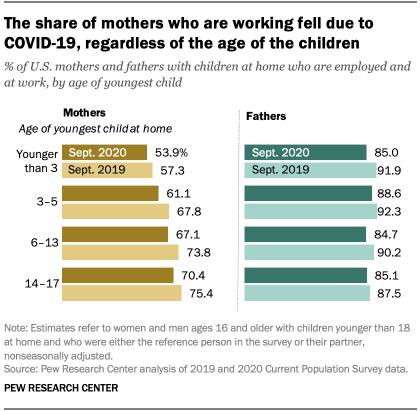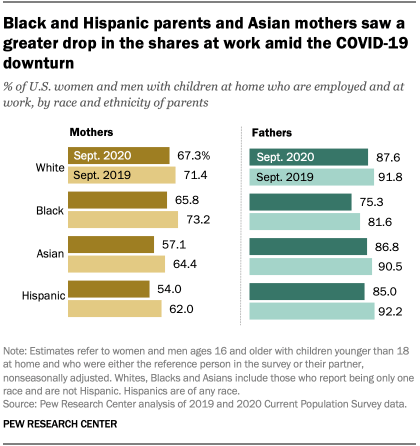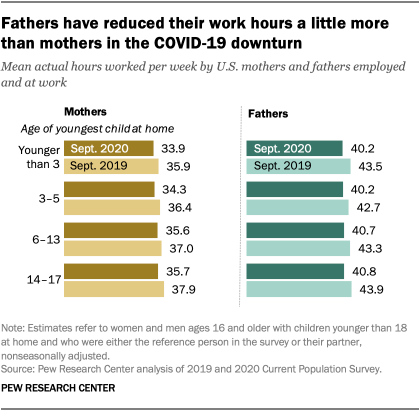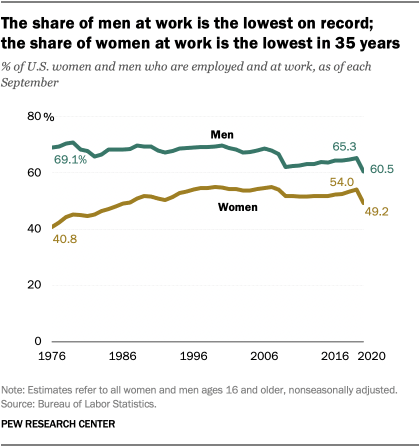
The COVID-19 recession has upended the lives of American workers, millions of whom remain without a job despite a recent upswing in hiring. Working parents have faced unique challenges as many schools and child care centers around the United States closed their doors due to the coronavirus outbreak. A new Pew Research Center analysis of government data finds that in the first six months of the pandemic, the workplace engagement of mothers and fathers with children younger than 18 at home has been affected about equally.
The shares of mothers and fathers who are working – employed and on the job – have fallen from 2019 to 2020, but the falloff has been comparable for each group. The shares of mothers who were not in the labor force edged up more than among fathers but, among those at work, fathers appear to have reduced their work hours more than mothers.
The COVID-19 outbreak has hindered the ability of child care centers and summer camps to resume normal operations and for many schools to fully open their doors to in-person learning. Many wondered if the outbreak would further entrench or widen the already substantial gap in the shares of mothers and fathers who are at work, and research into the initial impact of the downturn suggested this may be happening. This analysis looks at the impact on the labor market activities of mothers and fathers six months into the outbreak.
The focus is on the shares of mothers and fathers who are employed and at work, not absent for any reason. The employment level of men shows a seasonal pattern, peaking in the summer months. Absences from work, including for vacations, sick leave, maternity or paternity leave, child care or family obligations, also vary seasonally. Among women, the number employed and at work is typically lower in the summer months. For these reasons, our analysis focuses on changes from 2019 to 2020, largely eliminating the effect of seasonal variations.
Most estimates in this report are from a Pew Research Center analysis of data from the Current Population Survey (CPS), a survey of U.S. households conducted by the Bureau of Labor Statistics. The COVID-19 outbreak has affected data collection efforts by the U.S. government in its surveys, limiting in-person data collection and affecting the response rate. It is possible that some measures of labor market activity and how they vary across demographic groups are affected by these changes in data collection.
“Mothers” and “fathers” refer to women and men 16 and older who are either the reference person in the survey or their partner and who have a child younger than 18 living in the household. Grandchildren and foster children are included in the count of children. Partners include those who are married to or are cohabiting with the reference person, whether of the opposite sex or not. In September 2020, there were 32 million mothers and 27 million fathers with a child at home in a population of 201 million women and men ages 16 and older who were either reference persons or partners.
The term “employed and at work” refers to employed workers, full-time or part-time, who are not absent from work for any reason. Some reasons why a worker may be absent from work are vacations, maternity or paternity leave, child care and family obligations, and a labor dispute.
The labor force consists of people 16 and older who are either employed or actively looking for work. A worker who is not employed must be actively seeking work to be counted among the unemployed. The terms “unemployed” and “not employed” are used interchangeably in this report.
Earlier studies found that some mothers – more so than fathers – were cutting back on their work hours or taking leave from work at the beginning of the pandemic. But, over the first six months of the outbreak, the labor market impact of COVID-19 has similarly affected mothers and fathers, and the wide gulf that exists in the workplace engagement of mothers and fathers persists virtually unchanged. The share of mothers and fathers who were employed and at work plunged with the onset of the coronavirus outbreak and had recovered only partially through September 2020. The gender gap in September (22 percentage points) is slightly greater than in February (20 points), but a similar gap was also present in September 2019.
Labor market outcomes alone do not capture the full extent of the experiences of parents, such as the loss in leisure time or additional stress as they juggle work, child care and online learning. Given that mothers already assumed greater responsibility for child care than fathers, it is likely that the additional duties during COVID-19 – as many schools, day care centers and summer camps closed, at least temporarily – have fallen more on their shoulders. It is possible that these effects vary across mothers and fathers and that the gender gap on this account may change as the coronavirus outbreak extends its run.
Here are five facts about how labor market activity among women and men with children at home has been affected in the first six months of the COVID-19 outbreak. The focus is on the shares of mothers and fathers who are working – employed and at work – in September 2020 and how that compares with where things stood in September 2019.
The shares of mothers and fathers who were employed and at work in September 2020 were smaller than in September 2019. Among mothers, this share decreased from 69.0% to 63.4% and, among fathers, it decreased from 90.5% to 85.6% over this period. The drop in the share of mothers working was about the same as the drop among fathers, 5.6 vs. 4.9 percentage points.
Mothers and fathers who are employed but not at work may be absent for a vacation, illness, maternity or paternity leave, child care, and other family obligations, among several reasons. Because vacations or sick leave may also be taken for family reasons, our analysis does not attempt to distinguish among the reasons for absence from work. In September 2020, the share of those absent from work was 2.9% among mothers and 2.1% among fathers. Mothers and fathers experienced the same increase in this share in comparison with September 2019.
The downturn did increase unemployment across the board. Among mothers, the share of the working-age population, ages 16 and older, that was not employed increased from 2.2% in September 2019 to 4.7% in September 2020. Fathers saw a similar rise in the share not employed, from 1.7% to 4.5%.
A key difference between mothers and fathers is in the share who are not in the labor force – neither employed nor actively looking for work. Among mothers, 29.1% were not in the labor force in September 2020, compared with only 7.8% of fathers, a disparity driven in part by child care and other family obligations. This share was higher than in September 2019 among both mothers and fathers, with a slightly greater increase occurring among mothers than fathers (2.6 vs. 1.6 percentage points).
Among mothers, those with children ages 3 and older experienced a slightly greater decrease in the share employed and at work; among fathers, the decrease in this share was greater among those with children younger than 3. Reflecting the gender gap in childcare, mothers with children younger than 3 are less likely to be at work. In September 2020, 53.9% of these mothers were employed and at work, compared with 70.4% of mothers whose youngest child was 14 to 17 years old. These shares have dropped since September 2019 for all groups of mothers, with the decrease among mothers with children ages 3 to 5 or ages 6 to 13 (6.7 percentage points each) being greater than among other mothers.
Among fathers with children younger than 3, the share who were working fell from 91.9% in September 2019 to 85.0% in September 2020. The decrease in workplace activity was more modest among fathers with older children. For example, among fathers with children ages 14 to 17, the overall share who were at work fell from 87.5%% in September 2019 to 85.1% in September 2020.
Underlying these trends in the workplace engagement of mothers and fathers were changes in their labor force participation. Mothers with children ages 3 to 5 or ages 6 to 13 experienced more of a decrease in labor force participation, as did fathers with children younger than 3. Absences from work were largely unchanged among mothers and fathers regardless of the ages of their children.
Black, Asian and Hispanic mothers experienced a greater decrease in the shares who were at work in the COVID-19 downturn than White mothers. Among fathers, Black and Hispanic fathers saw a greater decrease in the share employed than White and Asian fathers.
In September 2019, 73.2% of Black mothers were at work, greater than the shares among White, Asian and Hispanic mothers. By September 2020, the share of Black mothers who were working stood at 65.8%, a drop of 7.4 percentage points. Asian and Hispanic mothers experienced drops of 7.3 and 8.0 points in the shares employed, respectively. The decreases in this share for White mothers – 4.1 percentage points – is also notable, but not as high, in keeping with the trends among women overall.
Black and Hispanic fathers saw a greater decrease in work activity than other fathers over the same period. In September 2019, 81.6% of Black fathers and 92.2% of Hispanic fathers were employed and at work. By September 2020, 75.3% of Black fathers and 85.0% of Hispanic fathers were at work. The decreases in the share working among White and Asian fathers were not as high.
Workplace engagement among Black, Asian and Hispanic mothers fell more than among White mothers because they left the labor force in greater proportions and they also experienced more of an increase in unemployment from September 2019 to September 2020. Similarly, Black and Hispanic fathers were more likely to have left the labor force than White and Asian fathers over this period, and unemployment increased more among Black, Asian and Hispanic fathers than among White fathers.
Fathers who are employed and at work cut back on the hours they spent on the job by a little more than mothers did. From September 2019 to September 2020, the average weekly hours worked by fathers fell from 43.3 to 40.5 – nearly three hours per week. At the same time, mothers pared their average weekly hours from 36.8 to 35.0, close to two hours per week. The change in work hours among mothers and fathers did not vary notably by the ages of the youngest children at home.
The key difference among mothers and fathers is that mothers spend significantly less time on the job, and the gender gap on this front is largely intact. The demands of family life have a large impact on this disparity, as is partly evident in the fact that women with younger children work the least number of hours whereas the age of a child has no impact on the hours worked by fathers.
Another manifestation of the gender gap in work hours is that women are more likely than men to work part time. In September 2019, 21.0% of mothers worked part time compared with 3.9% of fathers. In September 2020, the shares working part time stood at 20.3% for mothers and 4.3% for fathers. The slight decrease in the share of mothers working part time is likely a consequence of the fact that employment fell more sharply among part-time workers than full-time workers in the COVID-19 downturn.
Because of the COVID-19 downturn, the share of men overall who are working is at a record low. Among women, the share who are working is the lowest since the mid-1980s, when labor force participation among women was much lower and still on the rise.
In September 2020, 49.2% of women ages 16 and older were employed and at work, down from 54.0% in September 2019. Among men, the share who are active decreased from 65.3% in September 2019 to 60.5% in September 2020, the lowest on record since 1976, when data first became available.
It is worth noting that mothers and fathers who are referenced in this analysis and with children younger than 18 at home are more likely to be working than women and men overall. One reason is that these parents are younger on average than women or men overall, among those 16 and older: The mean age of mothers in September 2020 was 39, compared with 48 for women overall. The mean age of fathers was 42 compared with 46 for men overall.
Our analysis of the labor market engagement of mothers and fathers finds that, in the first six months of the COVID-19 outbreak, the gender gap on this front is perhaps more reflective of long-standing patterns in the labor market than of a new dynamic brought on by the outbreak. As business closures peaked in April and May, researchers found that, among married parents with children younger than 13 at home, mothers reduced their time worked by about one hour more than fathers from February to April.
Another study estimated that employed mothers with school-age children were more likely to take leave from work if they lived in states that imposed closures earlier. But this study also observed that mothers in early closure states did not change their labor force participation differently than fathers. Meanwhile, a New York Times survey conducted in April found that both women and men were doing more housework and child care than usual, although the division was about the same as before COVID-19 emerged.
Looking forward, the impact of the COVID-19 downturn on working parents, especially mothers, may intensify if business and school closures remain in effect. In a survey conducted in July by the Federal Reserve Board, 23% of employed mothers and 15% of employed fathers said they expected to reduce their work hours if schools did not resume in-person classes in the fall. Another 4% of working mothers and 2% of working fathers said they might quit their jobs.
